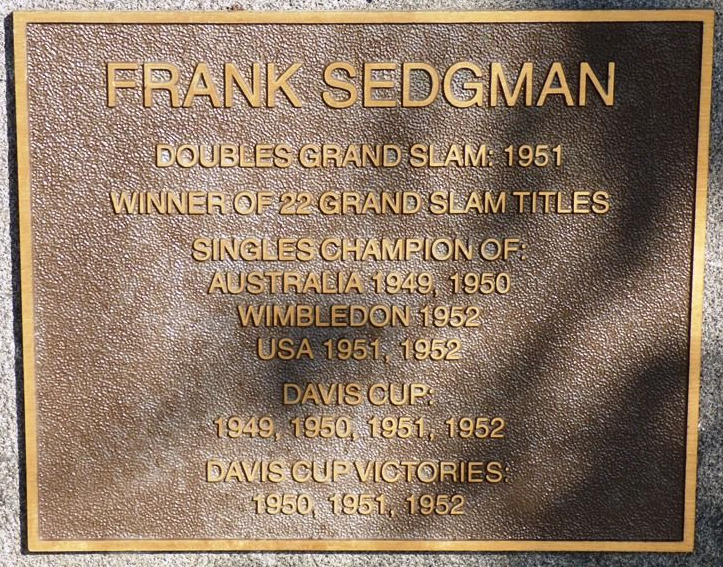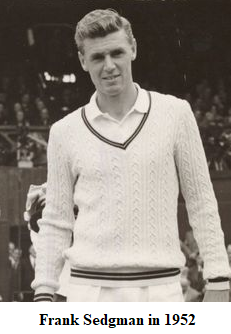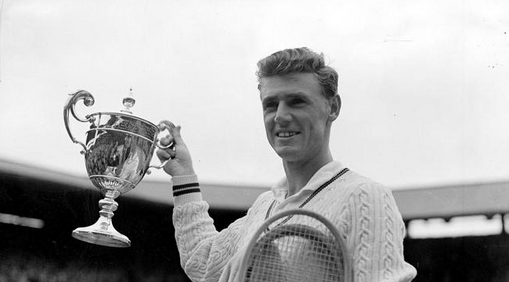
Many wonderful tennis players have come and gone over the years, but I still have a soft spot for the Australian champion Frank Sedgman. He was my father’s number one sporting hero (in equal place with the cricketer Keith Miller), and I can still remember listening to the Davis Cup matches of the early-1950s, with Sedgman taking on and cleaning up the top Americans. As a schoolboy I was once a ball-boy in a match at Kings Park Tennis Club in which Sedgman was playing, and I can still remember his flashing strokes, to say nothing of his superb athleticism, sportsmanship and good looks.
His style of play – coming to net behind both serve and return-of-serve to put away crisp, penetrating volleys – and his capacity to win points, rather than have his opponent lose them (as is so much the style today), was his  hallmark. It was said of Sedgman by the other pros that “no other top tennis player hit fewer second volleys”, the first nearly always being a clean put-away. He also had uncanny anticipation – the factor that lets so many modern players down when they occasionally venture to the net and then stand in the middle like a stranded fish. Sedgman would approach down the centre, but just as his opponent was about to strike the ball, he would dart to left or right and cut off the attempted passing shot. He also had an uncanny ability to “get out of his own way” – in other words to skip nimbly aside from the ball hammered straight at him, and then deal with it. His great doubles partner, Ken McGregor, was also a wonderful volleyer, but was vulnerable to the hard-hit ball coming directly at him.
hallmark. It was said of Sedgman by the other pros that “no other top tennis player hit fewer second volleys”, the first nearly always being a clean put-away. He also had uncanny anticipation – the factor that lets so many modern players down when they occasionally venture to the net and then stand in the middle like a stranded fish. Sedgman would approach down the centre, but just as his opponent was about to strike the ball, he would dart to left or right and cut off the attempted passing shot. He also had an uncanny ability to “get out of his own way” – in other words to skip nimbly aside from the ball hammered straight at him, and then deal with it. His great doubles partner, Ken McGregor, was also a wonderful volleyer, but was vulnerable to the hard-hit ball coming directly at him.
I have recently re-read Ellsworth Vines’ excellent book Tennis – myth and method, and a story about Sedgman caught my eye. Vines recounts how, in 1952, Sedgman played in the Pacific Southwest Tournament against Linn Rockwood and defeated him 6-0 6-0. Lockwood was twice US National Public Parks champion and was “as steady as a rock”. In the match against Sedgman, Lockwood didn’t make a single unforced error, but still could not win a game, scarcely could win a point. Every time he looked up, whether he was serving or receiving, Sedg was at the net putting away a volley or killing an overhead.
Vines was writing in 1978, well into the pro era, and he summed up Frank Sedgman as one of the top ten all-time players, on about a par with the older Pancho Segura and with the edge on Tony Trabert. Vines rated Lew Hoad, Ken Rosewall, Pancho Gonzales, Jack Kramer and Rod Laver as all being above Sedgman when they were playing at their top, but coming in #6 on a list like that is nothing to be ashamed of.
But I’d like to linger a bit further on 1952, as we celebrate the 70th anniversary of what was one of Australia’s greatest tennis years.

At Wimbledon that year Frank Sedgman won the men’s singles (above), the doubles (with Ken McGregor) and the mixed doubles (with Doris Hart), the only man ever to win the triple crown. He was also undefeated in singles and doubles in the 1951/52 Davis Cup, in which Australia cleaned up the US to take out the Final, won the 1952 US championship singles and mixed doubles, was runner-up in the Australian and French Championships, and won the Australian and French doubles championship.
And when I remember 1952, I also remember my father and the pleasure he derived from sporting champions like Frank Sedgman and Keith Miller. The opinion of an American like Ellsworth Vines meant nothing to Dad: in his eyes, Sedg was number one.
 Sign In
Sign In 0 Items (
0 Items ( Search
Search










We often remember how we, as kids, and as a family, used to be glued to the radio listening to the shot by shot commentary that skilfully enabled us to visualise the games being played by these giants as if we were actually there. What a contrast with the drivel being spouted by many if not most of the commentators today.
Sedgman and McGregor were our heroes, too, although we also had great respect for their American opponents, Vic Seixas and Tony Trabert who were also great sportsmen.
It was a wonderful era.
Doubting Thomas
With a few exceptions the commentary is atrocious, often continuing in a distracting way after the play resumes.
I’d turn it off but I’d miss the sounds coming from the play and the sound helps give a better feel for the atmosphere at the ground.
With a few notable exceptions it seems it’s often a competition between commentators to come up with the most inane comments possible. They do pretty well at that.
Oh the memories of that golden era of tennis for Australia. I can’t even recall one vaccination scandal then.
—
When I was a kid my older brother took me to see Ken Rosewall and Roy Emerson play one night at the old Kooyong courts. My brother never took me anywhere but he was trying to impress a new girlfriend with how very kind he was. I was happy to go along with the fraud.
—
I was thrilled. There was something both magical and relaxed about the atmosphere watching world class tennis at night in that unpretentious venue. What a contrast with the stadiums of today.
—
And the players all wore white! None of the garish fashion disasters you see on the courts at the Australian Open. Last night’s Kyrgios – Broady clash must already be hot favourite, even at this very early stage, to get the award for the worst dress of the tournament. They’ll be very hard to beat.
—
Maybe Kyrgios will dazzle Medvedev with his distracting garb – although it would be hard to think of Medvedev being dazzled by anything, even the roof falling in.
I remember my dad taking us on a trip to the Melbourne zoo in the early 50s when we were more interested in the tennis on the radio than the animals. Dad said the Australians were the best in the world.
.
If I remember correctly, that was the day my brother wrecked the little pony show by not letting the pony buck him off. The ringmaster said something like, “get off kid”.
.
Thanks Roger, for rekindling some great memories.